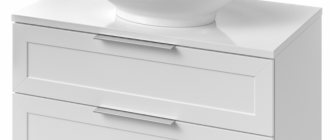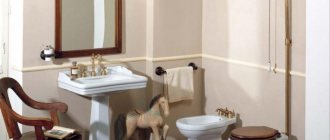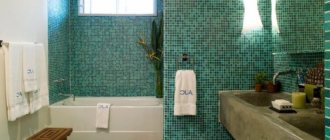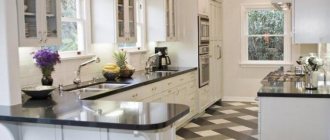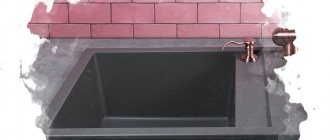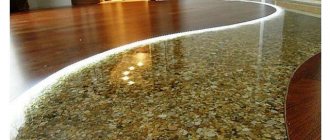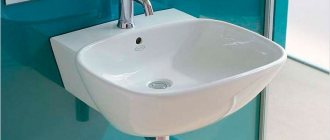Bathroom sinks. Selection rules
The decor of the bathroom largely determines our daily mood. In the morning we recharge here with energy, put ourselves in order and prepare for active activities, in the evening we relax, “wash away” problems and worries, getting ready for bed. Every item in this small room is important from both an aesthetic and functional point of view. For example, what should a bathroom sink be like to make water procedures even more comfortable?
Primary requirements:
- Proportionality. A bulky washbasin built into a cabinet will “eat up” the usable space of a small bathroom, and a compact model will get lost in a spacious room, disturbing the overall ensemble.
Tip: If the dimensions of the bathroom allow, it is recommended to install two sinks. Then the family will not have problems getting ready for work, study, etc. at the same time.
- Style unity. The design of the washbasin should not contradict the interior as a whole.
- Ergonomics. Will it be convenient to approach the sink? How easy is it to care for, are the pipes accessible for repair, will it be possible to wash the floor under and around the device without any problems? Where will personal hygiene products and household chemicals be stored? All these questions must be answered when choosing the appropriate model.
- Comfort and safety. If there are small children in the family, glass sinks pose a potential hazard. Hanging varieties are also not the best option, since cantilever mounting is not the most reliable. Optimally suitable are “tulip” models or models built into the tabletop, and the materials used are earthenware or artificial stone. It is better to choose an oval or round shape to reduce injuries.
Installation features
It is worth considering the following options for installing a sink:
- on the tabletop. In this case, you need to think about how to hide water pipes, for example, a siphon or installing pipes in the walls;
- The most practical option is installation on a cabinet. In this version, the pipes are hidden behind the doors. You can store household chemicals in the cabinet;
- An excellent solution for small bathrooms is to place it above the washing machine.
Installing a sink is generally not difficult. First, a tabletop or cabinet is installed. The cabinet is installed on legs, and the tabletop is attached to the wall and mounted on supports.
Installing a sink on a cabinet is considered a functional solution
If the sink is placed above the washing machine, then dowels and anchor bolts are used for fastening. Then the mixer and bowl are installed, and the pipes are connected.
Helpful information! After assembly, the structure is checked for leaks.
Mirror height
It is difficult to imagine a washstand in a bathroom without a mirror, which is installed separately or in a cabinet designed for storing hygiene items, detergents, medications, and cosmetics. Recommended mirror bottom height:
- 1100 - 1250 mm from the floor;
- 200 mm from the top of the washbasin;
- at eye level if a small mirror sheet is used.
When hanging a mirror, it is important to take into account the proportions; it is convenient for a person to look into it while standing straight, while it is advisable to remove the lower edge from the sink so that drops of water do not fall on it when washing.
Examples of mirror heights
Furniture under the sink
Overhead products are installed on the countertop, and hoses, couplings, pipes are removed to special hidden places under the countertop, against the wall or inside the structure.
- Furniture for the sink should be made of moisture-resistant material that will not be deformed by water drops.
- The optimal countertops are products made from artificial stone or marble. Such tables differ only in configuration, and they are produced for a specific size of standard sinks.
- A special cabinet or tabletop can be equipped with a bunch of shelves, drawers and compartments for storing cosmetics and detergents. This will keep the rest of the space uncluttered and add real and visual spaciousness to the bathroom.
- Open shelves, an upper cabinet and a mirror will complement the convenience of using a counter-mounted washbasin.
- You can show your imagination and order a countertop to match your bathroom interior. This will emphasize the sophistication and individual style of the room.
Types of bathroom sinks
When choosing washbasins, the main attention is paid to the installation method. First of all, its price and the ability to independently carry out all the necessary work depend on how easily the plumbing fixtures are attached.
Wall-hung washbasin
Such models are mounted directly on the wall, either using dowels or using brackets if the product is quite massive. Another option is to equip the sink with a hanging cabinet, which allows you not only to hide unattractive communications, but also to organize a reliable support with additional storage places.
Attention: When buying a washbasin, you need to pay attention to the hole for the mixer. If there is none, you will have to make a niche to hide the water pipes and install the faucet on the wall.
Hanging structures are ideal for small bathrooms, since the space under them remains free. Here you can install a laundry basket, shelves or a stand with bath accessories.
Washbasins look good in modern or retro interiors, but they are chosen much less often for classic or country interiors.
The disadvantage of the model is the problematic installation, which not everyone can cope with. The wall should only be solid; the partitions are unlikely to support the weight of the product.
In the photo there are wall-hung sinks in the bathroom:
Sink "Tulip"
The name of this type of washbasin very accurately reflects their design features. The bowl is installed on a separate pedestal, which masks the siphon and communications wiring. Externally, the shell really resembles a flower on a thin stalk.
The “tulip”, which has become a classic among plumbing fixtures, has several advantages:
- simplicity and reliability of fastening
- spectacular appearance
- compact dimensions
- affordable price, compared, for example, with overhead or built-in analogues
Tip: A pedestal sink is best suited for a classic-style bathroom. It will fit harmoniously into the interior. In addition, in a spacious room (and for classics only rooms with a large area are used) there are no problems with storing things. Which is important, because there is no room for them under such a washbasin.
You can see what “tulip” sinks look like in the bathroom in the following photos:
Countertop sink
One of the most popular models. It is a bowl mounted on some kind of base. Most often it is a cabinet, less often a tabletop with legs or a console.
The bowl-sink looks very stylish, which has earned it the love of consumers. But the model is in demand not only because of its original design. Among its advantages:
- speed and ease of installation
- Possibility of support on a tabletop of any size
- wide range of materials and decorative techniques used
- variety of shapes
- convenient sealing of joints, guaranteed protection against leakage
Important: all connection points with the countertop and insertion of communications must be carefully insulated to avoid dampness and the troubles that accompany it.
The only thing that can scare off consumers is the price of the overhead bowl. This is the most expensive model on the modern plumbing market.
The following photo shows examples of countertop sinks:
Built-in models
They come first in terms of practicality and ergonomics. Suitable for rooms of any size, and they are comfortable to use for both adults and children.
There are three types of countertop sinks in a bathroom:
- The sides of the bowl are above the surface of the base and rest on it. This type is the most common and easy to install.
- The bowl is located under the tabletop. Installation here requires certain professional skills: you need to ensure that the hole under the sink is slightly smaller than its size.
- Semi-built-in model, when the sink partially protrudes beyond the edge of the supporting plane. This option is optimal for small bathrooms.
The bathroom countertop under the sink serves several functions. This is a dressing table, a place to store personal hygiene products, and splash protection for the lower shelves or bedside table. And also a stylish piece of furniture that makes our bathroom unique.
It should be noted that built-in washbasins are less susceptible to cracks and chips than others; in addition, they are easy to clean, since the outer surface is closed and hardly gets dirty.
Photo of sinks with countertops for the bathroom:
Sink with cabinet in the bathroom
In a modern interpretation, such models are the closest relatives of the famous “Moidodyr”, they are pleasing to the eye and allow you to effectively organize space. On the one hand, the cabinet masks the “behind the scenes” of the plumbing, on the other, it serves as a spacious storage unit, allowing you to get rid of clutter.
In rooms with a large area, the size of the cabinet may well allow the installation of a washing machine in it. Using a cabinet under the sink is also advisable in small bathrooms, especially if the bathtub in them is replaced by a shower.
Tip: For small spaces, it is better to choose a wall-hung rather than a floor-standing cabinet. This model visually increases the space, is convenient for cleaning and suffers less from moisture, since ventilation is provided not only on the sides, but also from below.
Corner varieties are preferable to straight ones - they occupy less area.
What types of cabinets are there for a bathroom sink? Photo selection:
"Water lily"
A sink with a flat bottom and a horizontal drain is available specifically for installation above a washing machine. This is an excellent solution for small bathrooms, although the model has its drawbacks:
- The siphon of the structure periodically becomes clogged and has to be cleaned.
- There is a risk of flooding the electronic module of the washing machine with water.
- Household appliances are “in plain sight”, causing the appearance of the room to suffer.
And yet, sinks above the washing machine are irreplaceable, for example, in “Khrushchev” apartments and other bathrooms of similar sizes.
Advice: it is better to purchase a ready-made kit: a mini-automatic machine designed for installation under a washbasin and a bowl - today this “duet” is offered by many leading manufacturers.
Examples of “water lilies” in the photo below:
Corner sink in the bathroom
This model will make even a tiny bathroom comfortable, using the usually empty area at the junction of two walls.
Corner sinks are:
- hanging
- with pedestal
- built-in
The first option is good for lovers of long water treatments and relaxation who do not accept showers. In this case, a compact asymmetrical bathtub comes to the rescue, above the narrow part of which there is a hanging corner washbasin. This technique allows you to save space and increase the ergonomics of the room.
By choosing a built-in corner sink for a small bathroom, we will provide ourselves with additional storage space. Occupying a minimum of space, the vanity cabinet is very spacious due to its great depth.
Interesting examples in the photo:
Greetings from the USA: disadvantages and advantages of a double sink
Probably, many have seen photos of American houses and noticed one feature in them - almost always a double sink is installed in the bathroom, and two baths are the norm in the USA. In our houses and apartments, this trend is just beginning to gain popularity. In this article we will try to understand the disadvantages and advantages of double sinks.
Double sink: what is it and why?
In the morning, many families are faced with a lack of time for everyone to have the opportunity to wash their face and brush their teeth fully and without rushing. Sometimes you even have to get up early to do this. This problem can be partially solved by installing a double sink in the bathroom. It allows you to use bathroom space with double efficiency.
Double sink is very convenient for a large family
Most often, double vanities consist of two sinks fastened together or placed on the same pedestal. Sometimes this can be a tray the length of two sinks with one swivel faucet or two separate ones located on opposite sides of the tray.
The number of siphons also depends on the choice of sink type. If you decide to install a sink of the first type, then you need one siphon, but if you have a sink described in the second option, then you need a double siphon.
Double bathroom sink: materials
When choosing a bathroom sink, you need to pay attention to the material from which it is made.
- Ceramics. Porcelain or earthenware sinks are already familiar to most.
They are distinguished by their attractive appearance, suitable for any interior design, hygiene and environmental friendliness. Such sinks are not afraid of scratches and temperature changes, but they are quite fragile. If you drop a heavy object into such a sink, there is a high probability that the washbasin will crack and become unsuitable for further use. Ceramic sink - Porcelain tiles differ from conventional ceramic sinks by the addition of granite chips.
This makes the products not only convenient and practical, but also gives them high strength. Such sinks are not afraid of mechanical damage, even heavy falling objects. Double washbasin in porcelain stoneware - Glass double sinks are highly versatile because they can be made in a variety of color options.
In addition, the glass can be matte, glossy, corrugated or perfectly smooth. Glass can take any shape, so the variety of design solutions here is also quite high. For the manufacture of washbasins, high-strength and tempered glass is used, so you don’t have to worry about mechanical damage and excessive fragility. This material does not absorb dirt, odors and moisture, however, with increased water hardness, traces of plaque may remain on the glass. Double glass washbasin - Composite materials are used quite often to make sinks.
Sinks made of artificial stone are environmentally friendly, durable, resistant to household chemicals and mechanical damage. However, such sinks also have a disadvantage - the large weight of the product. Double sink made of artificial stone - Natural stone is highly decorative, but is quite demanding to care for, and can also absorb odors and coloring pigments.
A natural stone - Stainless steel is sometimes used to make bathroom sinks, but this material is more suitable for kitchens, so the choice of this material is often based on design decisions.
In addition, such a sink can create unnecessary noise in the bathroom. Double washbasin in stainless steel - Bronze and copper are very beautiful materials for making sinks, but at the same time they are also quite capricious.
During operation, such washbasins require constant maintenance. Copper sinks
Advantages and disadvantages of a double sink
The undoubted advantages of a double sink include:
- Expanding the washing area . In many ways, this device resolves conflict situations that arise in the family due to the fact that someone takes too long to preen in front of the mirror, while another does not have time for work due to the inability to approach the washbasin.
- Isolation of infection. The fewer people who use one common item, including the sink, the lower the risk of contracting various infections from each other. It is normal practice in Western countries to install sinks for children and adults separately. As a result, diseases brought by children from schools and other institutions are rarely transmitted to parents and vice versa.
- Personal space. Double sinks increase the amount of personal space that many people need. Ideally, each family member should have not only a separate sink, but also a cabinet for personal hygiene items.
The presence of two sinks will allow family members to slowly perform hygiene procedures
Flaws:
- High requirements for free space. Given the small dimensions of the bathroom, there can be no talk of installing this plumbing miracle.
- Price. Prices for such products are usually high, which may make you think about the advisability of purchasing it. However, if this brings the desired peace of mind to the house, then few people will pay attention to this factor.
- Cleaning. Efforts to bring cleanliness are doubled, because now not one sink should shine, but two.
Advice. Having free space in the bathroom is a very important factor. If you want to install a double sink in a small bathroom, it is best to draw a plan in advance that will clearly show how much free space will remain. You should not install two sinks if this will be done to the detriment of everything else.
Double sink installation options
Installing double sinks is not much different from installing a regular vanity. By type they are also divided into wall-mounted, built-in and overhead.
The easiest to install would be a counter-mounted washbasin with a cabinet included. All that needs to be done for it to work is to connect the mixers to the water supply and install siphons.
Countertop double washbasin with cabinet
Wall-mounted washbasins are a little more difficult to install, but they are the cheapest in their segment. To connect, in addition to supplying water and installing a siphon, you also need to fix the washbasin to the wall on special supports.
The built-in sink is mounted by inserting into the countertop. Everything else is done in the same way as with other shells.
Advice. When purchasing a double sink united by a common body, do not forget to ask the seller about a special siphon that allows you to connect both drains to a tee, thanks to which you do not have to redo the sewer system.
When choosing a double sink, you need to correctly assess the capabilities of your bathroom. In all other respects, you will feel the convenience and its undoubted advantages from the first days of use. And a large selection of different shapes and types will allow you to implement even the most daring design in your bathroom, better than in any photos in glossy magazines.
What building codes say
Owners of private homes are given quite a lot of freedom in planning the placement of plumbing fixtures in the bathroom. However, certain standards are still present. As a rule, they are designed to regulate the construction parameters of bathrooms.
In addition, it contains recommendations regarding the distance between individual plumbing products:
- The dimensions of a bathroom in residential and public buildings are defined as 80x120 cm. The ceiling height is from 250 cm.
- In bathrooms located inside the attic, the toilet may be installed no closer than 100-110 cm from the corner walls. Otherwise, it will be inconvenient to send natural needs.
- When using a swing door, the leaf comes out when opened.
- The corridor leading to the room can have a height of 210 cm.
The modern design of combined bathrooms, along with traditional plumbing, allows for the installation of objects such as a shower stall, bidet, etc.
Recommendations in this regard are as follows:
- The space from the bathtub or shower to another element is from 70 cm. As a result, a person receives the necessary freedom of movement.
- The toilet and bidet should be separated by a space of 25 cm. This will allow you to perform hygiene procedures without interference.
- The toilet must have a platform in front of it of at least 60 cm. The gap dimensions on both sides are from 25 cm.
- The front edge of the washbasin and any other fixed objects in the bathroom should be separated by a space of at least 70 cm.
These rules have been drawn up to regulate design throughout the country. They allow you to calculate in advance the dimensions of a bathroom washbasin with and without a cabinet. As for premises intended for disabled people and people with mobility problems, different building regulations apply in these cases. This directly relates to the planning and arrangement of sanitary facilities where such people will be served.
For public bathrooms used by disabled people, the following standards apply:
- Width – from 160 cm.
- Length – from 180 cm.
In places of permanent residence of people who have various mobility problems, the length of the bathroom is, if possible, increased to 220 cm. As for combined bathrooms, the requirements for their length and width are identical (minimum - 220 cm). For convenience, special handrails are installed inside them. The rule does not change for swing doors - they must open outwards (however, it is better to install a sliding model).
As for the dimensions of the sink with a bathroom cabinet, they must be precisely adjusted. In some cases, it is better not to use such models at all. First of all, this applies to situations where a wheelchair user lives in the house. A wall-mounted washbasin installed at a low height would be more convenient for it. To avoid any problems with the design of the alteration, the project must be drawn up in accordance with these standards.
Comparative analysis of materials
Our washbasins can withstand heavy loads, because in addition to hygiene procedures, they are often used for washing or playing (if we are talking about small children). You can accidentally drop a heavy bottle of cosmetics into the bowl, or hit it while turning awkwardly in the cramped space of the bathroom.
In addition, the sink is affected by water, the composition of which is far from ideal, and aggressive household chemicals that damage the top coating.
Therefore, the product material must be:
- durable
- durable
- resistant to mechanical and chemical influences
- with good decorative characteristics
Let's look at the most popular options.
Plumbing faience
Ceramic is the best choice for a bathroom sink. A wide range of design solutions, resistance to moisture and detergents, including abrasives, ease of maintenance are just a small list of the advantages of this material.
Thanks to modern technologies, earthenware washbasins have ceased to remain snowy white, but have sparkled with all the colors of the rainbow. Colored bathroom sinks offer great expressiveness and a variety of designs. They will fit perfectly into both classic and modern interiors.
Disadvantages of ceramic products:
- heavy weight
- cracking of the top glazed layer over time
- low impact resistance, which leads to cracks and chips that are almost impossible to repair.
In the photo - faience washbasins:
Glass
Glass bathroom sinks are at the peak of popularity today. With proper hardening, this seemingly fragile material becomes durable and resistant to the specific microclimate of bathrooms.
Spectacular design is another advantage of glass. Transparent bowls made of it make the interior light and airy.
However, glass sinks have one significant drawback - they are difficult to maintain. Limescale deposits, streaks and stains are immediately noticeable, and they are not easy to remove, since compounds with abrasive particles and brushes can leave visible scratches on the surface.
To be on the safe side, families with small children should avoid glass, even tempered glass.
Photos of glass bowls in the interior:
Metal
Less aesthetically pleasing enameled washbasins have become a thing of the past; they have been replaced by high-quality products made of copper or stainless steel (see photo).
Metal sinks are more rare than common, although they are durable, beautiful and easy to maintain.
Among the disadvantages: limescale stains are visible on the bowl, and water makes a loud sound when it comes into contact with the surface of the washbasin.
Marble vs artificial stone
There are styles that require either luxurious or exotic decoration. This is classic, art deco and ethno. In this case, a ceramic or glass washbasin is unlikely to be a worthy choice.
But sinks made of natural stone in the bathroom will look great. They usually use durable, low-porous rocks: granite, onyx or marble. Such products have a high cost, which is justified by the complexity of their processing and the exclusivity of the material.
Marble is considered the most vulnerable of the listed minerals. It requires regular cleaning, otherwise an unpleasant, difficult-to-remove plaque will form on the sink. Chips and cracks are also a constant threat to marble plumbing fixtures.
Artificial stone is no less beautiful than its natural counterparts, but is affordable and has better performance characteristics. The material based on polymers and stone chips is suitable for any style, which is easy to see by comparing the photos we presented:
Tree
This material is rarely used in the manufacture of sinks. Products made from it are considered elite and are made by hand with special processing and impregnation with water-repellent compounds.
Wood requires special care - it should be cleaned only with neutral detergents and a soft sponge. If the protective top layer is damaged, the washbasin will quickly become unusable under the influence of water.
Attention: every four years the wooden sink will have to be restored to extend its service life.
Overhead sinks: review of prices and manufacturers
An overview of popular manufacturers and prices is presented in the table:
| Image | Manufacturer and country | Model | Material | Average cost, rub. |
| Hidra Ceramica (Italy) | Hidra A44 | Ceramics, faience | 12 300 | |
| Vitra (Türkiye) | Vitra Geo | Faience, ceramics, metal, wood | 10 800 | |
| Sheerdecor (India) | Sheerdecor Ronda | Stone | 23 800 | |
| Desegno Ceramica (Italy) | Desegno Ceramica Sfera | Ceramics | 21 800 | |
| GSI (Italy) | GSI Panorama Ellipse | Faience, ceramics | 15 900 | |
| Kraus (USA) | Kraus Nei G.V. | Glass | 27 900 | |
| Makro (Italy) | Macro Cup | Faience | 37 500 | |
| Ideal Standard (Belgium) | Ideal Standard Strada K077701 | Faience | 7 400 | |
| Linkasink (USA) | Bronze Wing Bowl | Metal | 75 000 | |
| Franco Ceccotti (Italy) | Franco Ceccotti Wave | Tree | 112 000 |
Using useful recommendations, you can choose the ideal model to suit your interior style and your financial capabilities. A high-quality countertop sink in combination with a countertop will provide comfort and coziness in the bathroom, and will also complement the already created environment.
Customer Reviews
Vera, Moscow: “We fixed the sink at a height of 95 cm. It was convenient for me and my husband, only my son (he is two years old) could not reach the tap even on a chair. The problem is that the hoses from the mixer did not reach the pipes - the plumber brought them out as standard. I had to lower the sink. When finishing a bathroom, I advise you to install water supply and sewerage systems above the norm.”
Alexey, Moscow: “I have a sink at a height of 105 cm. With my height of 175 cm, it is comfortable. My arms, bent at the elbows, do not touch the bowl. Lumbar chondrosis is not scary. But shorter people have to move their elbows out to the sides.”
Shell shape
Modern washbasins can be:
- rectangular
- oval
- round
- square
- asymmetrical
The rectangular sink is considered the most versatile. It is suitable for bathrooms of any size and style:
A round bathroom sink looks unusual and creates a memorable image:
But perhaps the most stylish bathroom sinks are oval:
Soviet sink installation standard
In the Soviet years, the corresponding norms were calculated. These are GOST standards that specifically indicated at what height the sink must be installed. In our age, these figures are advisory in nature, since no one checks the distance from the accessory to the surface.
Standard installation height for the product in the bathroom
With any method of installing the sink, you need to take into account the designed installation height from the floor surface. During the years of the USSR, standardization organizations functioned, which developed uniform standards for fixing accessories. Studying the details helped determine the optimal height for installing the sink in relation to the floor.
The indicator was calculated based on the height of an ordinary person.
The calculations included the average height of a woman. It has been established that the most comfortable height for installing a sink is the range from 80 to 92 cm. If we consider the height of a man, this figure varies from 85 to 102 cm from the floor.
Sink options
Siphon connection diagrams
Regardless of the design of bathtub sinks and methods of their installation, siphons are traditionally used:
- single-turn;
- double-turn;
- bottle.
The use of a one- or two-turn siphon is typical for “water lilies”, when it is necessary to free up as much free space under the sink as possible to accommodate a washing machine or other household items.
The name “single-double turn” was obtained due to the presence of one or two pipe bends in the circuit. Due to such bends, a hydraulic seal is created inside the line.
The principle of operation of siphons is the same, but the design is different. This difference allows you to connect different types of sinks to the sewerage system without changing the recommended circuit
Another option, “bottle”, is the most common. It differs from the first in the absence of bends, the functions of which are performed by a special “bottle” with a drain pipe diverted from the top of the structure. This scheme is more convenient than the first when performing maintenance - cleaning the line in case of a blockage. At the bottom of the “bottle” there is a technical cap that can be easily unscrewed.
Overhead bath sink: where and how to install
There are several ways to install an overhead sink:
- on the tabletop. The disadvantage of this placement is the openness of sewer and water pipes. In this case, recessing the supply lines into the walls and using a special decorative siphon - chrome or stainless steel - will help to avoid the unaesthetic component;
- on the cabinet. The most practical option for placing an overhead sink: communications are hidden behind furniture doors and, importantly, they have quick and constant access. In addition, the space of the nightstand provides additional storage space for household chemicals;
- above the washing machine. Ideal for placement in small bathrooms and bathrooms.
Round ceramic sink set on a marble countertop
Installing an overhead sink, as a rule, does not cause any particular difficulties. Installation is easy to do with your own hands:
- First, a cabinet or tabletop is installed, which has a special cut-out hole on the surface for installing a drain pipe. The cabinet is placed on legs, the tabletop is fixed to the wall and, in some cases, equipped with additional supports;
- The sink for placement above the washing machine is attached to the wall. For this, anchor bolts or dowels are used;
- then the bowl and mixer are installed;
- then the water and sewer pipes are connected;
- The finished structure must be tested for leaks.
Installation principle of an acrylic countertop washbasin
Bathroom Sink Dimensions
The dimensions of the washbasin are selected depending on the area of the room and specific needs. A spacious bathroom does not necessarily need a large sink; you can install two smaller bowls if, for example, several people use the bathroom at the same time in the morning.
The optimal width of a standard sink is 50 – 65 cm. The depth should be approximately the same. The height of the device is usually 80 – 85 cm.
The maximum width of the sink is 90 cm. To increase its dimensions, it is recommended to use double models.
Significant measurements of a plumbing fixture
Beautiful shapes, original ideas in the catalogs of famous manufacturers - all this plunges you into shock when you have to choose a washbasin. Often you want to comply with the latest trends in design, surprise your friends and get maximum comfort during use.
There are only four main criteria to follow when measuring a sink. They play an important role in choosing a product - if you overlook it, then later the product will clearly disappoint.
An example of taking measurements from a standard sink. Explanations for the diagram: L – sink length, B – product width, H – depth
Among the important parameters are the following:
- product depth;
- distance to drain;
- width;
- length.
Depth. This is the measurement from the top of the structure to the inside of the bowl. It is he who indicates the comfort of further use - you should not take less than 15 cm. Regardless of how attractive the designer’s idea may be.
Distance to drain. The parameter affects whether the product fits well in the space allocated to it, taking into account the location of the communication outlets. It is measured from the top cut of the bowl to the lowest protruding point in the bottom. The measurement is taken on the outside.
Width is the number of centimeters from the outside of the device to the innermost side, which will be in contact with the wall of the room. Here you should focus specifically on measurements taken on top of the product, including the sides.
If you take the width and length indicators along the inner walls of the bowl without taking into account the width of the side, there is a high probability that the chosen option simply will not fit into the niche allocated to it in the bathroom
Length. The measurement should be taken from right to left - from the right wall to the left, including the sides. Otherwise, the sink will protrude far beyond its allocated space.
These are all standard values that the manufacturer indicates in the passport for their product. If you do not want to ask the consultant for an accompanying document, all measurements can be taken using a tape measure. They have to be compared with the parameters characteristic of your bathroom.
Types of washbasins
Based on size, plumbing fixtures are conventionally divided into types:
- mini-sinks or compact-sized appliances. The products are mainly used in restrooms;
- products with standard sizes;
- extended washbasins. This type includes tandems of two sinks or products combined with a countertop;
- exclusive models that are made to order.
Bathroom sinks
Be sure, before going to the store to buy a sink, you need to take measurements of the space for the plumbing. This will help you choose the right product that will fit perfectly with other plumbing fixtures.
Types of overhead sinks
Any bathroom should have an attractive appearance and be comfortable to be in. Practicality is one of the main rules for organizing the interior of these premises. A properly selected sink plays an important role in the design - a device for personal use.
To create a harmonious interior in which it is easy to relax or recharge your batteries, you should choose plumbing fixtures of the same style. The comfort of using this abode of cleanliness depends on the design, functionality, and color scheme. Any sink performs one function - it is used for hygiene procedures.
When choosing a sink for a bathroom, you should decide on the shape and material of the plumbing fixture. It is worth approaching this issue with full responsibility. There are many materials from which these structures are made. The most popular are:
- Ceramics has earned the love of customers; it is the most common material used to make plumbing fixtures. It is represented by porcelain and earthenware. These materials have a smooth surface, which makes them easy to care for; ceramic products are durable and chemically resistant. But it is worth considering that they are highly fragile;
- Wood is considered the most unsuitable material for the manufacture of this kind of product, but this opinion is erroneous. There are modern technologies that allow you to create a true masterpiece that will bring elegance and charm to the bathroom. These products are durable, they are treated with special impregnations that protect the material from moisture. They look stylish and have an unlimited service life;
- Glass has been used for the production of sinks for a long time, and you won’t see any kind of washbasins made from this unusual material. It is worth considering that for the manufacture of such products, tempered glass, which is not so easy to break, or triplex is used. They can withstand enormous loads and temperature changes; some types of material are resistant to scratches. The main thing about glass products is that they require constant care;
- Stone sinks allow you to create an interior that amazes with its splendor and richness. They can be made from natural and artificial stone. The first option is much more expensive, artificial stone is cheaper, it perfectly imitates natural materials. These products have high wear resistance, strength and rich texture. But caring for them is difficult, they have significant weight;
- Metal is often associated with the simple and cheap washbasin that we are used to seeing in inexpensive places. In fact, there are models that amaze with their uniqueness; they can easily be classified as elegant and unusual art objects. Steel, bronze, nickel, brass are used to make sinks; the materials can be matte or shiny. In any case, such a product looks elegant and respectable. The only drawback of metal structures is their noise when interacting with water.
The variety of forms is also striking. There are all sorts of sinks you won’t find in plumbing stores. Round and oval, rectangular, semicircular and corner sinks are presented to consumers; these shapes are most in demand on the market. They can be made in the form of a thicket or a flower.
There are products with an exclusive design in the shape of a coffee cup or a flower bud, you can find an original solution and purchase a figure of an unusual non-standard shape, for example, there are options in the form of a fancy blot. Problems with choice most often arise precisely because of such a wide range presented to customers.
With the help of these designs you can embody any design style. A round version will look harmonious in a corner; rectangular and oval products will fit perfectly on a cabinet along the wall in the center or offset. The main thing is to ensure free access to the sink. The size of the selected product also depends on the installation location.
The standard sizes of overhead washbasins are width 40-55 cm, depth 12-35 cm - these are small products. Large sinks are 75-120 cm wide and 48-61 cm deep. Non-standard appliances are usually made to order according to individual parameters.
Sinks can be purchased with or without an overflow. This point should be taken into account when purchasing an overhead structure. As a rule, the siphon comes in conjunction with the main element. In some cases, siphons are equipped with a special nut, which, using sealant, securely fixes the structure to the surface.
Depth level
In addition to width, you need to pay attention to depth parameters. Depth plays an important role. If it is small, it will lead to unpleasant problems - water splashing, water getting on the walls, floor and even on clothes. Therefore, in order to purchase a quality product, you need to know the depth parameters. The optimal depth of the washbasin is no less than 48 centimeters, but no more than 62 centimeters. To measure the depth level, it is not at all necessary to take a ruler with you. In the selection process, you need to get close to the plumbing fixtures, stretch out your hand and see where it ends - if it’s in the middle of your palm or at the tips of your fingers, then you can buy the sink right away.
Shell depth
Source
Share the news on social networks
- Related Posts
- Terrace with barbecue in a private house
- Cork backing for laminate: features and characteristics of the material
- How many meters to retreat from the fence when building a house, bathhouse, barn, garage according to SNiP and construction standards
« Previous entry
Tips for choosing a countertop sink
- First of all, you should pay attention to the size of the product . To do this, you need to come close to the washbasin and extend your hand. Ideally, the borders of the countertop sink should end at your fingertips. The size will also need to be taken into account if there are several washbasins on the countertop.
- Quite often, countertop models are sold without faucets. Therefore, it is necessary to choose a product that will match the purchased mixer.
- For a home where small children live, it is recommended to opt for models with smooth curves or rounded shapes. It is better to avoid metal washbasins with sharp corners.
- Pay attention to the presence of overflow. If it is missing, you will need to install a drain valve instead of the bottom tap.
- To select a countertop sink of a comfortable depth, you will need to lean over it and, simulating washing your face, pay attention to whether your elbows hit the sink. If everything is fine, then the product can be purchased.

